
The Hunterian is a complex of museums located in and operated by the University of Glasgow in Glasgow, Scotland. It is the oldest museum in Scotland. It covers the Hunterian Museum, the Hunterian Art Gallery, the Mackintosh House, the Zoology Museum and the Anatomy Museum, which are all located in various buildings on the main campus of the university in the west end of Glasgow.

Glasgow Royal Concert Hall is a concert and arts venue located in Glasgow, Scotland. It is owned by Glasgow City Council and operated by Glasgow Life, an agency of Glasgow City Council, which also runs Glasgow's City Halls and Old Fruitmarket venue.
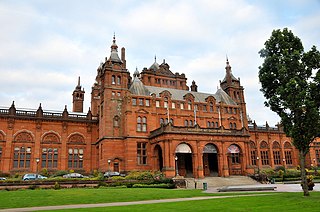
Kelvingrove Art Gallery and Museum is a museum and art gallery in Glasgow, Scotland, managed by Glasgow Museums. The building is located in Kelvingrove Park in the West End of the city, adjacent to Argyle Street. Kelvingrove Art Gallery and Museum is one of Scotland's most popular museums and free visitor attractions.

Kelvingrove Park is a public park located on the River Kelvin in the West End of the city of Glasgow, Scotland, containing the Kelvingrove Art Gallery and Museum.
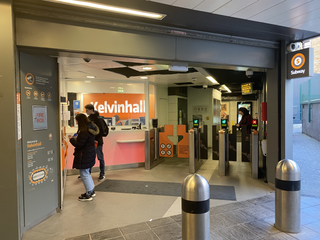
Kelvinhall is an underground station on the Glasgow Subway, renamed after the nearby Kelvin Hall. It is located in the West End of Glasgow, Scotland, near to many of the city's best known tourist destinations including:

Pollok House, formerly the family seat of the Stirling-Maxwell family, is located at Pollok Country Park in Glasgow, Scotland.
The city of Glasgow, Scotland, has many amenities for a wide range of cultural activities, from curling to opera and from football to art appreciation; it also has a large selection of museums that include those devoted to transport, religion, and modern art. In 2009 Glasgow was awarded the title UNESCO Creative City of Music in recognition of its vibrant live music scene and its distinguished heritage. Glasgow has three major universities, each involved in creative and literary arts, and the city has the largest public reference library in Europe in the form of the Mitchell Library. Scotland's largest newspapers and national television and radio companies are based in the city.
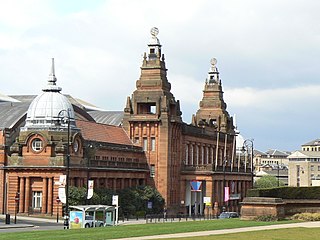
The Kelvin Hall International Sports Arena was located within the Kelvin Hall in Glasgow, Scotland. It hosted many athletics competitions including the 1990 European Athletics Indoor Championships and the Glasgow International Match from 1988 until 2012 when it moved to the Commonwealth Arena.
Blythswood Hill, crowned by Blythswood Square, is an area of central Glasgow, Scotland. Its grid of streets extend from the length of the west side of Buchanan Street to Gordon Street and Bothwell Street, and to Charing Cross, Sauchiehall Street and Garnethill. Developed from 1800 onwards, its Georgian and Victorian architecture is a Conservation Area. It started as the "Magnificent New Town of Blythswood", becoming a part of the city-centre's business and social life.
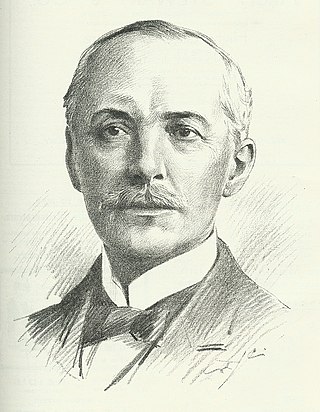
Sir John James Burnet was a Scottish Edwardian architect who was noted for a number of prominent buildings in Glasgow and London. He was the son of the architect John Burnet, and later went into partnership with his father, joining an architectural firm which would become an influential force in British Modern architecture in the 20th century.

The Empire Exhibition was an international exhibition held at Bellahouston Park in Glasgow, Scotland, from May to December 1938.

Caird Hall is a concert auditorium located in Dundee, Scotland. It is a Category A listed building.

Glasgow Cross is at the hub of the ancient royal burgh and now city of Glasgow, Scotland, close to its first crossing over the River Clyde. It marks the notional boundary between the city centre and the East End

The Royal Exchange Square is a public square in Glasgow, Scotland. The square lies between Buchanan Street and Queen Street, opening out Queen Street and Ingram Street to the south of George Square. It is also easily accessible from Buchanan Street on the west side of the square, through two prominent archways at Royal Bank Place. The square is a landmark due to its distinguished architecture which attracts many visitors. It is one of six squares in the city centre.

The Riverside Museum is a museum in the Yorkhill area of Glasgow, Scotland, housed in a building designed by Zaha Hadid Architects, with its River Clyde frontage at the new Pointhouse Quay. It forms part of the Glasgow Harbour regeneration project. The building opened in June 2011, winning the 2013 European Museum of the Year Award. It houses many exhibits of national and international importance. The Govan-Partick Bridge, which will provide a pedestrian and cycle path link from the museum across the Clyde to Govan, is set to be completed in 2024.
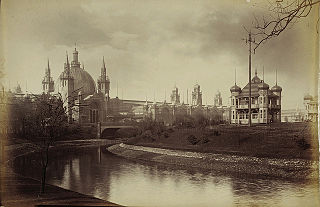
The International Exhibition of Science, Art and Industry was the first of 4 international exhibitions held in Glasgow, Scotland during the late 19th and early 20th centuries. It took place at Kelvingrove Park between May and November 1888. The main aim of the exhibition was to draw international attention to the city's achievements in applied sciences, industry and the arts during the Industrial Revolution. However, it was also hoped the Exhibition would raise enough money for a much-needed museum, art gallery and school of art in the city. The exhibition was opened by the Prince of Wales, as honorary president of the exhibition, on 8 May 1888. It was the greatest exhibition held outside London and the largest ever in Scotland during the 19th century.

William Leiper FRIBA RSA (1839–1916) was a Scottish architect known particularly for his domestic architecture in and around the town of Helensburgh. In addition, he produced a small amount of fine ecclesiastical and commercial architecture in Glasgow and the Scottish Lowlands. He was also an accomplished watercolour artist, and from the late 1870s spent much spare time painting in oils and watercolours.

The Glasgow International Exhibition was the second of 4 international exhibitions held in Glasgow, Scotland during the late 19th and early 20th centuries. The exhibition took place during a period of half-mourning requested by Edward VII but was still popular and made more than £35000 profit. The exhibition was opened by the King's daughter, the Princess Louise, Duchess of Fife.

John Baird (1799–1859) was a Glasgow architect of the 19th century, also called John Baird Primus by Thomas Gildard in order for people to be able distinguish him from a second John Baird (1816-93). He was an influential figure in the development of Glasgow’s late Georgian and early Victorian Architecture. He was responsible for around 40 projects and worked in the "background" compared to other Glasgow architects.


















